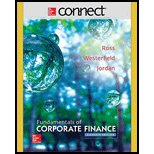
Concept explainers
| Year | Cash Flow (A) | Cash Flow (B) |
| 0 | $43,500 | $43,500 |
| 1 | 21,400 | 6,400 |
| 2 | 18,500 | 14,700 |
| 3 | 13,800 | 22,800 |
| 4 | 7,600 | 25,200 |
a. What is the IRR for each of these projects? Using the IRR decision rule, which project should the company accept? Is this decision necessarily correct?
b. If the required return is 11 percent, what is the NPV for each of these projects? Which project will the company choose if it applies the NPV decision rule?
c. Over what range of discount rates would the company choose project A? Project B? At what discount rate would the company be indifferent between these two projects? Explain.
a)
To calculate: The IRR (Internal rate of return) for the proposed projects of Company G, the project that the company must accept and discuss whether the decision made is appropriate.
Introduction:
The IRR (Internal rate of return) is a rate of discount, which makes the predictable investment’s NPV equal to zero.
The NPV (Net present value) is a capital budgeting technique, which is used to assess the investment, and it is utilized to identify the profitability in a proposed investment.
Answer to Problem 12QP
As IRR is higher in Project A when compared to Project B, then Project A can be accepted. However, it is not the appropriate decision because the criterion of IRR has a problem in ranking of mutually exclusive projects.
Explanation of Solution
Given information:
Company G has identified two mutually exclusive projects where the cash flows of Project A are $21,400, $18,500, $13,800, and $7,600 for the years 1, 2, 3, and 4, respectively. The cash flows of Project B are $6,400, $14,700, $22,800, and $25,200 for the years 1, 2, 3, and 4, respectively. The initial costs for both the project are $43,500, respectively.
Note:
- NPV is the difference between the present values of the cash inflows from the present value of cash outflows.
- The IRR is the rate of interest, which makes the project’s NPV equal to zero. Hence, using the available information, assume that the NPV is equal to zero and form an equation to compute the IRR.
Equation of NPV to compute IRR assuming that NPV is equal to zero:
Compute IRR for Project A using a spreadsheet:
Step 1:

- Type the equation of NPV in H6 in the spreadsheet and consider the IRR value as H7.
Step 2:

- Assume the IRR value as 0.10%.
Step 3:

- In the spreadsheet, go to the data and select the what-if analysis.
- In what-if analysis, select goal seek.
- In “Set cell”, select H6 (the formula).
- The “To value” is considered as 0 (the assumption value for NPV).
- The H7 cell is selected for the “By changing cell”.
Step 4:

- Following the previous step, click OK in the goal seek. The goal seek status appears with the IRR value.
Step 5:
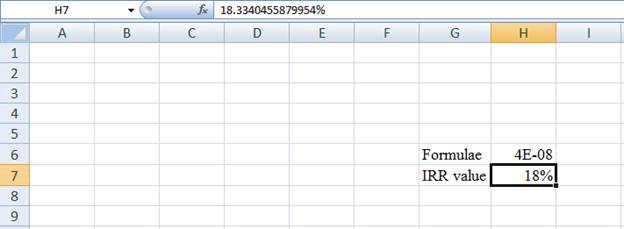
- The value appears to be 18.3340455879954%.
Hence, the IRR value is 18.33%.
Compute IRR for Project B using a spreadsheet:
Step 1:

- Type the equation of NPV in H6 in the spreadsheet and consider the IRR value as H7.
Step 2:

- Assume the IRR value as 0.10%.
Step 3:
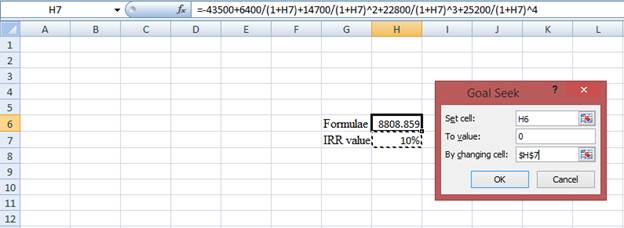
- In the spreadsheet, go to the data and select the what-if analysis.
- In what-if analysis, select goal seek.
- In “Set cell”, select H6 (the formula).
- The “To value” is considered as 0 (the assumption value for NPV).
- The H7 cell is selected for the “By changing cell”.
Step 4:

- Following the previous step, click OK in the goal seek. The goal seek status appears with the IRR value.
Step 5:
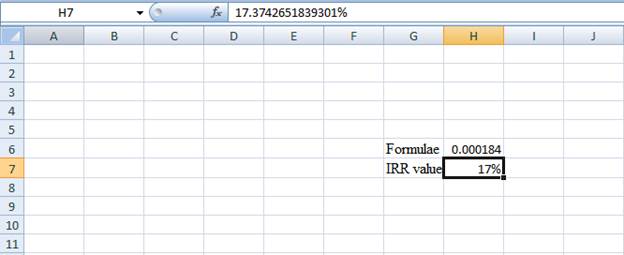
- The value appears to be 17.3742651839301%.
Hence, the IRR value is 17.37%.
b)
To calculate: The NPV for the projects to choose the best project for the company.
Introduction:
The IRR (Internal rate of return) is a rate of discount, which makes the predictable investment’s NPV equal to zero.
The NPV (Net present value) is a capital budgeting technique, which is used to assess the investment, and it is utilized to identify the profitability in a proposed investment.
Answer to Problem 12QP
As NPV is greater in Project B, the company must accept Project B.
Explanation of Solution
Given information:
Company G has identified two mutually exclusive projects where the cash flows of Project A are $21,400, $18,500, $13,800, and $7,600 for the years 1, 2, 3, and 4, respectively. The cash flows of Project B are $6,400, $14,700, $22,800, and $25,200 for the years 1, 2, 3, and 4, respectively. The initial costs for both the project are $43,500, respectively.
Note:
- NPV is the difference between the present values of the cash inflows from the present value of cash outflows.
- The IRR is the rate of interest, which makes the project’s NPV equal to zero. Hence, using the available information, assume that the NPV is equal to zero and form an equation to compute the IRR.
Formula to calculate the NPV:
Compute NPV for Project A:
Hence, the NPV for Project A is $5,891.09.
Compute NPV for Project B:
Note: The rate is given at 11%.
Hence, the NPV for project B is $7,467.80.
c)
To calculate: The rates of discount at which the company will select Project A and Project B, and the discount rate in which the company will be indifferent in selecting between the two projects.
Introduction:
The IRR (Internal rate of return) is a rate of discount, which makes the predictable investment’s NPV equal to zero.
The NPV (Net present value) is a capital budgeting technique, which is used to assess the investment, and it is utilized to identify the profitability in a proposed investment.
Answer to Problem 12QP
At the rate of discount above 15.19%, the company must choose Project A and for the rate below 15.19%, the company should choose Project B. Hence, it is indifferent at the discount rate of 15.19%.
Explanation of Solution
Given information: Company G has identified two mutually exclusive projects where the cash flows of Project A are $21,400, $18,500, $13,800, and $7,600 for the years 1, 2, 3, and 4, respectively. The cash flows of Project B are $6,400, $14,700, $22,800, and $25,200 for the years 1, 2, 3, and 4, respectively. The initial costs for both the project are $43,500, respectively.
Note:
- NPV is the difference between the present values of the cash inflows from the present value of cash outflows.
- The IRR is the rate of interest, which makes the project’s NPV equal to zero. Hence, using the available information, assume that the NPV is equal to zero and form an equation to compute the IRR.
Equation to calculate the crossover rates:
Compute the discount rate using spreadsheet:
Step 1:

- Type the equation of NPV in H6 in the spreadsheet and consider the R value as H7.
Step 2:

- Assume the R value as 10%.
Step 3:

- In the spreadsheet, go to the data and select the what-if analysis.
- In what-if analysis, select goal seek.
- In “Set cell”, select H6 (the formula).
- The “To value” is considered as 0 (the assumption value for NPV).
- The H7 cell is selected for the “By changing cell”.
Step 4:

- Following the previous step, click OK in the goal seek. The goal seek status appears with the R value.
Step 5:
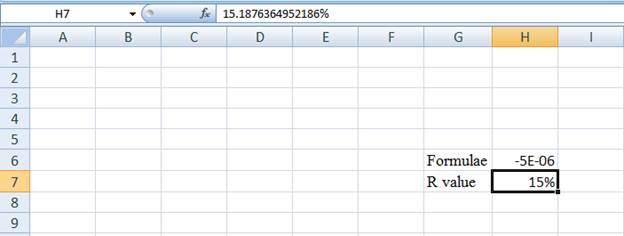
- The value appears to be 15.1876364952186%.
Hence, the R value is 15.19%.
Want to see more full solutions like this?
Chapter 9 Solutions
Connect 1 Semester Access Card for Fundamentals of Corporate Finance
- 9. Calculating Payments [LO3] The Bandon Pine Corporation's purchases from suppliers in a quarter are equal to 75 percent of the next quarter's forecast sales. The payables period is 60 days. Wages, taxes, and other expenses are 20 percent of sales, and interest and dividends are $110 per quarter. No capital expenditures are planned. Projected quarterly sales are shown here: Sales Q1 $2,250 Q2 $2,730 Sales for the first quarter of the following year are projected at $2,475. Calculate the company's cash outlays by completing the following: Payment of accounts Wages, taxes, other expenses Long-term financing expenses (interest and dividends) Total Q3 $2,390 Q4 $2,190 Q1 Q2 Q3 Q4arrow_forwardThe average daily net transaction accounts of a local bank during the most recent reserve computation period is $341 million. The amount of average daily reserves at the Fed during the reserve maintenance period is $26.20 million, and the average daily vault cash corresponding to the maintenance period is $5.8 million. (Example13-2). a. Under the rules effective in 2020, what is the average daily reserve balance required to be held by the bank during the maintenance period? b. Is the bank in compliance with the reserve requirements?arrow_forwardWhat are the LSS and characteristics of LSS tools used in a research study? What is Lean Six Sigma and what is the possible benefits of using Lean Six Sigma? What are the seven LSS tools, could you please explain the characteristics of each tool, and state how the tool would be used to in a case study? How Lean Six Sigma brings a hint of all three traditional types of research (qualitative, quantitative, and mixed methods) to bear on Case Study research and business solutions?arrow_forward
- Select a real-world case situation. Use this case which you either know about already or have identifiedthrough research and address the following questions in essay format:.i. Outline and discuss what “triggered” the regulatory body to intervene? ii. How effective do you think the response was to such a crisis? iii. Outline and discuss two ways that could be used to strengthen the current regulatoryarrow_forwardle Shema actencial de theophile cautionarrow_forwardYou plan to purchase a $200,000 house using either a 30-year mortgage obtained from your local savings bank with a rate of 7.25 percent, or a 15-year mortgage with a rate of 6.50 percent. You will make a down payment of 20 percent of the purchase price. Calculate the amount of interest and, separately, principal paid on each mortgage. What is the difference in interest paid? Calculate your monthly payments on the two mortgages. What is the difference in the monthly payment on the two mortgages?arrow_forward
- Problem 2-21 Financial Statements Use the following information for Ingersoll, Incorporated. Assume the tax rate is 23 percent. 2020 2021 Sales Depreciation $ 19,073 $17,436 1,811 1,886 Cost of goods sold 4,729 4,857 Other expenses 1,021 899 Interest 870 1,001 Cash 6,292 6,916 Accounts receivable 8,190 9,877 Short-term notes payable 1,320 1,297 Long-term debt 20,770 25,011 Net fixed assets 51,218 54,723 Accounts payable 4,624 5,094 Inventory 14,538 15,438 1,700 1,768 Dividends Prepare a balance sheet for this company for 2020 and 2021. (Do not round intermediate calculations.) Cash Assets Accounts receivable Inventory INGERSOLL, INCORPORATED Balance Sheet as of December 31 2020 2021 $ 6,292 $ 6,916 8,190 9,877 14,538 15,438 Drov 14 of 20 Nearrow_forwardProblem 6-35 Financial Break-Even Analysis The technique for calculating a bid price can be extended to many other types of problems. Answer the following questions using the same technique as setting a bid price; that is, set the project NPV to zero and solve for the variable in question. Martin Enterprises needs someone to supply it with 152,000 cartons of machine screws per year to support its manufacturing needs over the next five years, and you've decided to bid on the contract. It will cost $1,920,000 to install the equipment necessary to start production; you'll depreciate this cost straight-line to zero over the project's life. You estimate that, in five years, this equipment can be salvaged for $162,000. Your fixed production costs will be $277,000 per year, and your variable production costs should be $10.60 per carton. You also need an initial investment in net working capital of $142,000. The tax rate is 22 percent and you require a return of 12 percent on your investment.…arrow_forwardYou plan to purchase a $100,000 house using a 30-year mortgage obtained from your local credit union. The mortgage rate offered to you is 8.25 percent. You will make a down payment of 20 percent of the purchase price. Calculate the amount of interest and, separately, principal paid in the 225th payment. Calculate the amount of interest paid over the life of this mortgage.arrow_forward
- What are the back ground of Sears problem, and what are the general of the problem statements? How to Create problem statements and applicable research questions? What are the lessons learned from Sears that business people or organization should avoid?arrow_forwardWhat are the research assumptions, and the research limitations, please give examples for each one, and explain how the limitation in the example might be mitigated? What are the research delimitations and give one example please. Hhow Biblical principles are related to reliability and validity.arrow_forwardWhat are the six sources of data collection and please help to explain the qualitative data collection methods. What is the thematic analysis? How to anticipated themes in a research proposal?arrow_forward
 Intermediate Financial Management (MindTap Course...FinanceISBN:9781337395083Author:Eugene F. Brigham, Phillip R. DavesPublisher:Cengage Learning
Intermediate Financial Management (MindTap Course...FinanceISBN:9781337395083Author:Eugene F. Brigham, Phillip R. DavesPublisher:Cengage Learning
